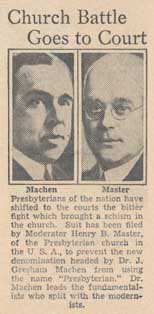A Rescue on Their Honeymoon
The seminary president had finally tied the knot in marriage with his secretary Grace Sanderson. The happy couple went west from the campus in Delaware to the Grand Canyon for their honeymoon. It was a trip which included the joys of married love, the rapture of God’s creation in the Canyon, the thrill of hiking on the trails of that part of the state of Arizona, the rescue of the World War II flyers who had crashed in their bomber over the Canyon . . . wait, while on their honeymoon, they rescued crashed flyers? Yet that was the experience of Allan and Grace MacRae on their honeymoon on June 21, 1944.
 The event was widely reported in newspapers around the country. Even a year later, the daring rescue was still being talked about. We quote from an article written by the Rev. Donald E. Hoke (later to become one of the founding fathers of the PCA), that appeared in the June 1945 issue of Sunday magazine :
The event was widely reported in newspapers around the country. Even a year later, the daring rescue was still being talked about. We quote from an article written by the Rev. Donald E. Hoke (later to become one of the founding fathers of the PCA), that appeared in the June 1945 issue of Sunday magazine :
When he rescued three army airmen from the depths of the Grand Canyon last summer, the Philadelphia Bulletin headlined him as “Bearded, Bespectacled, Theological Bridegroom.”
The editor’s description was timely, but by no means exhaustive of the versatile mountain-climber’s talents and appearance. For by profession, Allan A. MacRae is a semitic scholar, archaeologist, teacher, and president of a fast-growing interdenominational seminary with a nation-wide influence.
Front page publicity sky-rocketed him into prominence last June when together with a veteran ranger he descended the heretofore unscaled north wall of the Grand Canyon (Ariz.) and led out three fliers who had been marooned in the inaccessible gorge for a week.
Pictures of him, looking more like a Forty-niner than a dignified theologian as he brought the men out, made the front page on all big city dailies and news reels, for the marooned fliers had been spot news for a week. And the circumstances surrounding his presence in the canyon made a human interest story the news hounds devoured.
For Allan MacRae and his bride of less than a month were honeymooning in the beautiful but desolate valley where he was drafted for the rescue….
Rushed to the opposite side of the canyon by army jeep, MacRae and a veteran ranger studied maps of the steep north wall and started down. Soon they discovered a narrow deer trail, invisible on air maps, and followed it 550 feet down the famous precipitous Red wall. Camping over night at its base, they found the three men the following day and started back the miraculous route they had discovered.
The Rev. Vaughn Hathaway adds to our story with this interesting comment:
[The news clipping] refers to the bomber as a “heavy” bomber. It was not. It was a “medium” bomber, a B-25.
The B-25 normally carried a five-man crew. The accounts I have read said that this flight had only four men aboard. It had taken off from Nellis Air Base in Nevada on a training mission. Over the Grand Canyon, the plane had a mechanical problem which prompted the pilot to instruct the other three men of the crew to bail-out, thus setting up the circumstances of the rescue that followed.
The accounts that I heard said that the pilot was able to recover the plane and return to base. The stories did not indicate that the reduction of weight or a correction of the mechanical problem permitted the safe return of the plane.
Dr. MacRae was alleged to be one of only a few Caucasian men who were allowed to hike and camp in the northern part of the Grand Canyon park. His presence in the Canyon area at the time was a providence of God. The accounts given by Myers and Hoke indicate that the fliers were isolated for nearly a week during which several failed attempts to rescue them had taken place.
Mr. Tom Taylor, an Old Testament and Hebrew professor at Faith Seminary once gave an account of a long “walk” that he had taken with Dr. MacRae. He said that he had taken off like the rabbit in “The Turtle and the Hare,” while Dr. MacRae set out at a pace he had learned hiking in Europe. Taylor said that initially, he had taken a considerable lead on MacRae; but as the “walk” progressed, MacRae gradually overtook Taylor and reached their destination in the lead.
Words to Live By:
Back in Wilmington, Delaware a few weeks later, MacRae was besieged with invitations to tell his story. At first he demurred, then decided that there might be an unparalleled opportunity to give a gospel message…
“Like the fliers, all men are lost, in the abyss of sin. For them, there is no way out. Their need? A revelation from above, like the messages parachuted to the marooned men. But it is not enough to then just know your lost condition, some one must help you out. And Jesus Christ, he concludes, is God’s rescuer to lost men—He descended to our level that He might bring us back to His.”


